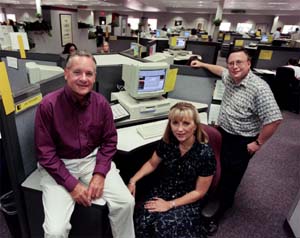Improved call centers pay well,
boost Tucson's high tech future

Benjie Sanders / Staff
Local industry leaders shown at the Teletech
building include, from left, Paul Hawkins, call center manager
for USA Relay Telecommunications; Barb Kjose, Teletech's site
director; and Fred Gould, Mileage Plus Inc. general manager of
customer service.
|
By Jonathan J. Higuera
ARIZONA DAILY STAR
The public perception of the teleservices industry looks
something like this: rude, low-paid telemarketers calling the moment
dinner is set on the table.
Some of those perceptions may have been true in the past, but
that's no longer the case at most Tucson call centers, industry
representatives maintain.
About 80 percent of the area's call centers handle only inbound
calls, said Fred Gould, general manager of Mileage Plus Inc., which
deals with United Airlines' frequent flyer program.
And starting pay for many call center workers is now $8 to $9 an
hour - far more than the $5.30 to $6.50 an hour starting pay that
was the norm just a few years ago.
"Labor rates have gone up significantly," Gould said. "It's now
on par with or even better than other retail service jobs."
The industry's impact on Tucson extends far beyond jobs and
telephone calls. Call centers need sophisticated phone lines, which
are something the entire city enjoys, said Luci Ponticelli, vice
president of recruitment at the Greater Tucson Economic Council.
So without call centers, Tucson would have less of the fiber
optic infrastructure, capital equipment and telecommunications
network systems needed for high-tech development, she said.
With some 32 call centers employing about 16,000 workers, call
center workers make up about 5 percent of the area's total work
force.
Three years ago, America Online had one call center here with 400
employees. Today the Dulles, Va.-based Internet provider has more
than 1,000 workers here in three buildings, including 250 workers in
promising technical development jobs.
Still, the industry battles perceptions that call center jobs
aren't the ones Tucson wants or needs.
Industry representatives are working to change that image. One
strategic move was to merge the old teleservices cluster into the
information technology cluster. In one fell swoop, it became part of
a formal organization with a paid executive director and dues-paying
members, plus increased access to IT cluster resources. And it
linked itself to an industry with a sparkling image.
"Our industry sees this as a much more focused way of doing
business," said Paul Hawkins, head of the old teleservice cluster
group and call center manager at USA Relay Telecommunications.
The old teleservices cluster was loosely organized, with no
dues-paying members and no real access to any resources beyond the
generosity of certain call center companies.
For their part, IT representatives saw the merger as a chance to
build membership and incorporate an industry that is an intensive
user of information technology.
"It's a pool of workers high-tech companies can draw on," said
Todd Sander, the city's information technology director and co-chair
of the Information Technology Association of Southern Arizona. "They
are on the front lines of telecommunications infrastructure."
Many of the workers hired in the city's information technology
department started in teleservices, Sander said.
One program seeking to foster that kind of career move is "Train
to Gain," which started in January. The comprehensive program trains
promising teleservice workers for entry-level information technology
jobs.
So far, about 70 teleservice workers are participating in the
program. For those workers who do make the jump, the financial
payoff is handsome.
According to the state Department of Economic Security's 1999
employment survey, a customer service representative makes an
average of $9.66 an hour and a telemarketer averages about $8.29 an
hour. But a computer support specialist who provides technical
assistance makes about $18.72 an hour.
Debbie Cross, vice president of Arizona Mail Order, which has
about 600 workers in its call center, said she's seen many call
center workers go on to other positions with the parent company,
Fingerhut.
"We sell our company as a career path," she said. "You can move
to positions within and outside the call center."
GTEC's Ponticelli has been recruiting call centers to Tucson
since 1988. She said they usually fall into three categories: those
that do telemarketing sales, those that receive calls for customer
service support or toll-free information and those that offer
high-end technical or financial services support.
"There is a perception in the marketplace that Tucson is
saturated," she said. "Those that decide to come now will likely be
more technical in nature."
There are several reasons behind Tucson's success in attracting
call centers, said John Boyd, a Princeton, N.J.-based corporate
relocation specialist who has studied the Tucson market.
"Tucson is a rather attractive location from a cost standpoint,"
he said. "You also have a growing labor market."
The city's disaster-free reputation helps, too, Boyd said.
"We look for locations that are well insulated from natural
disasters," he said. "Tucson offers a good deal of insulation."
* Contact Star Business reporter Jonathan J. Higuera at
573-4104 or at higuera@azstarnet.com.
Next month:
Bioindustry
Back to
Information Technology | Back to New
Economy home
| 
